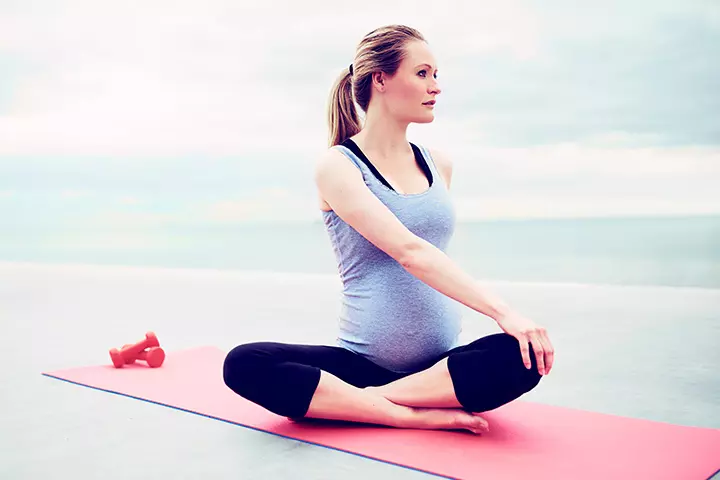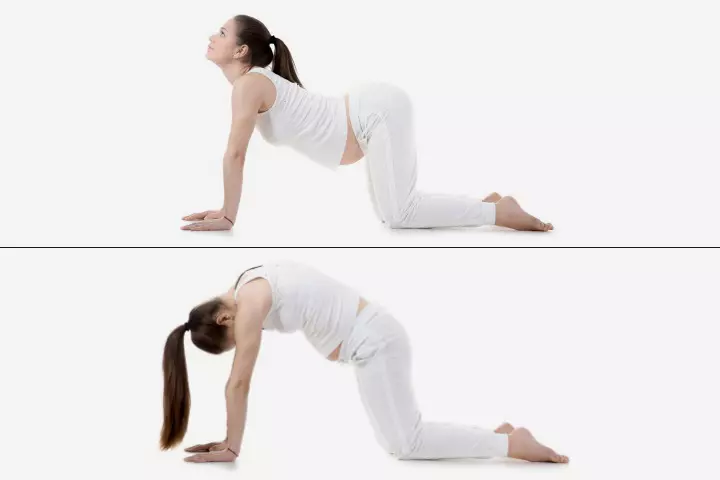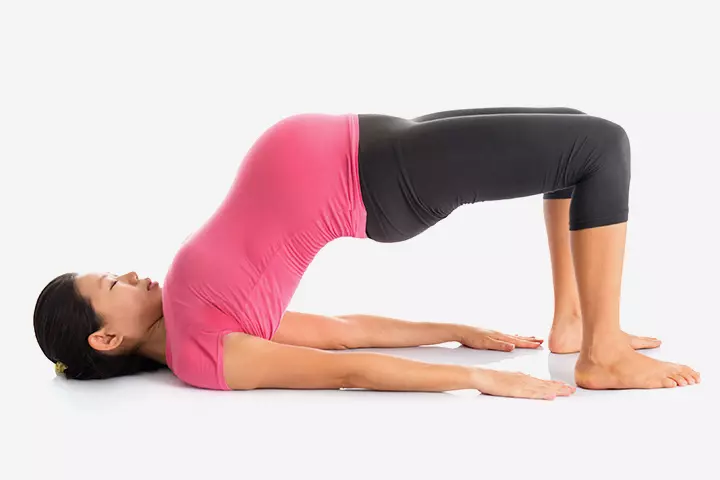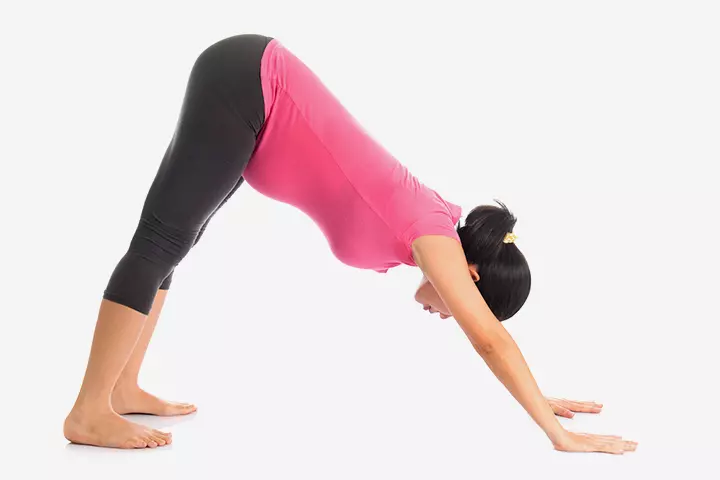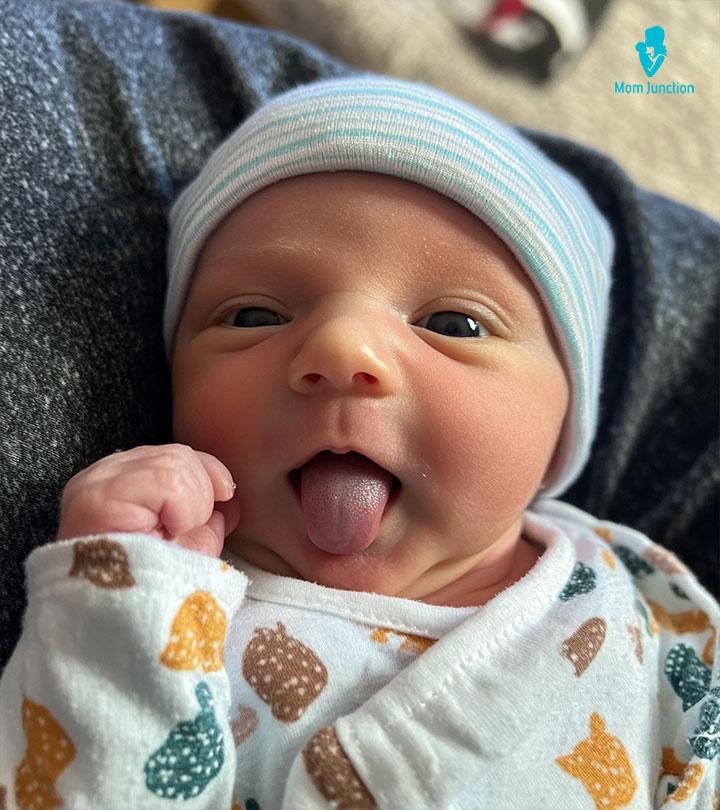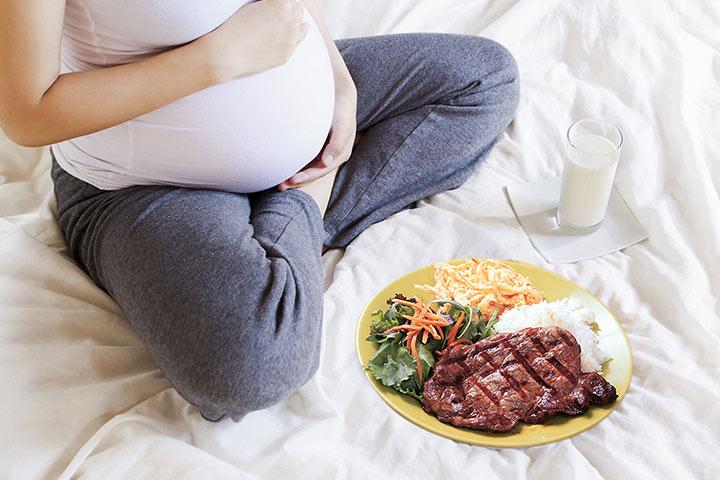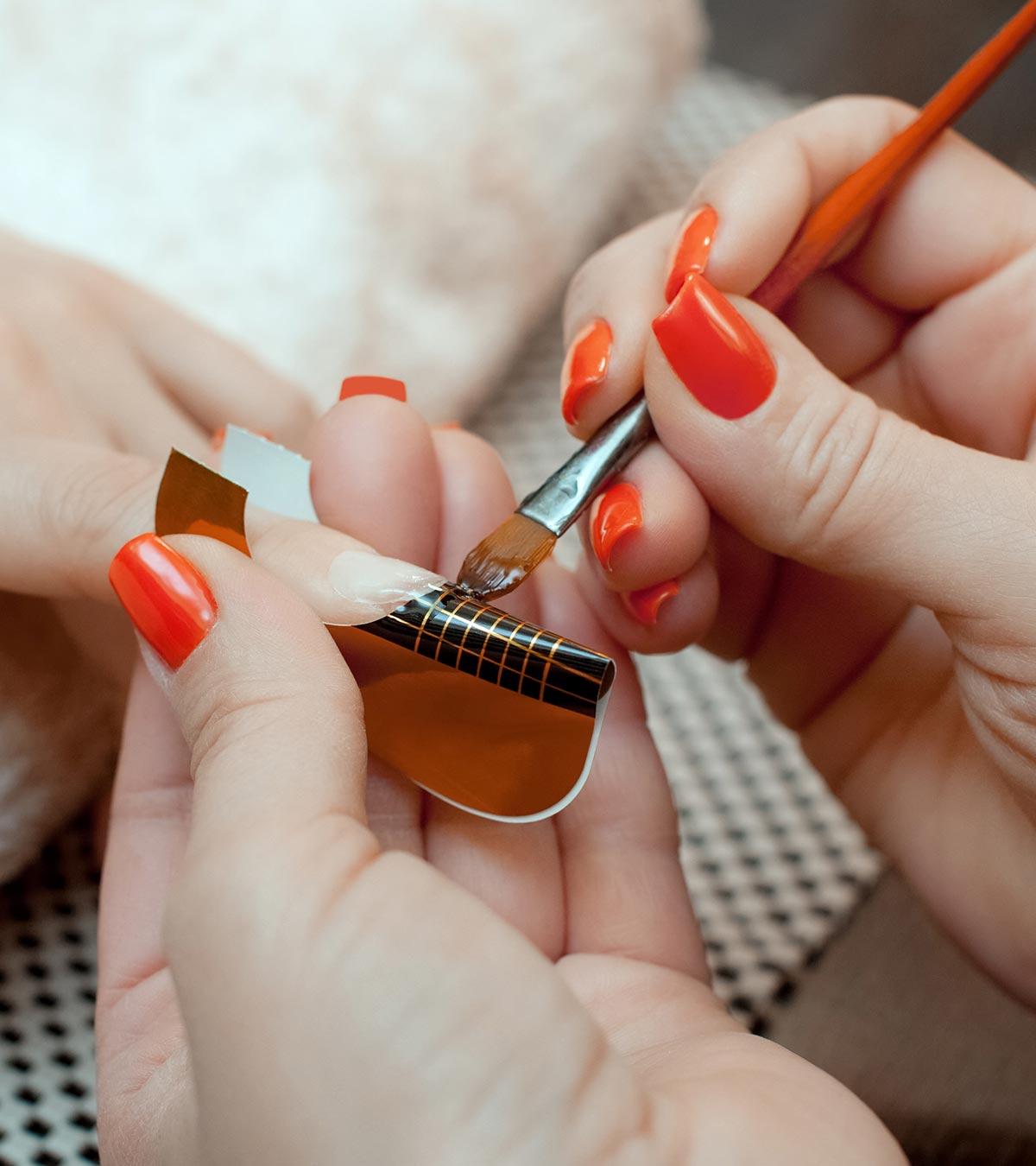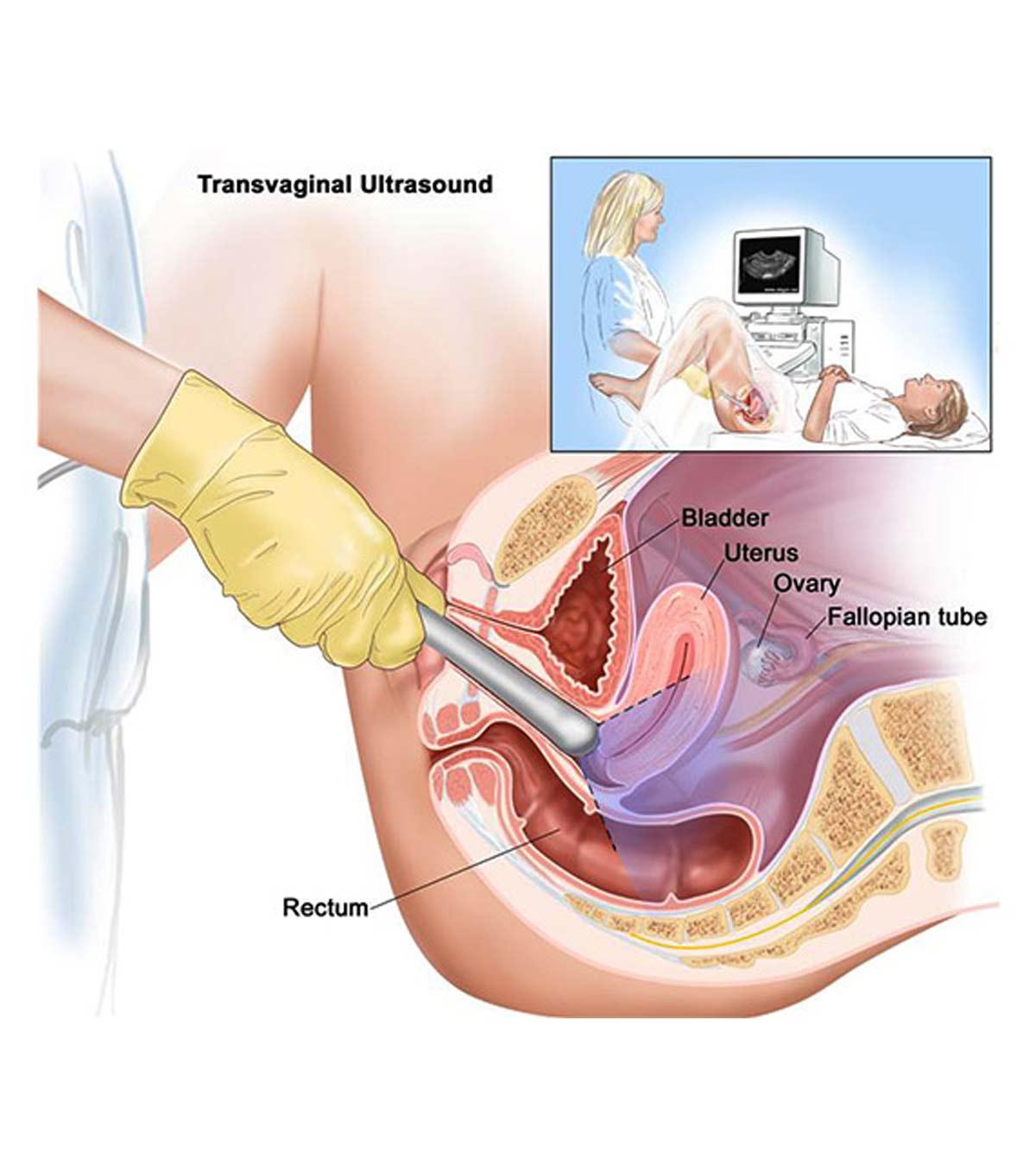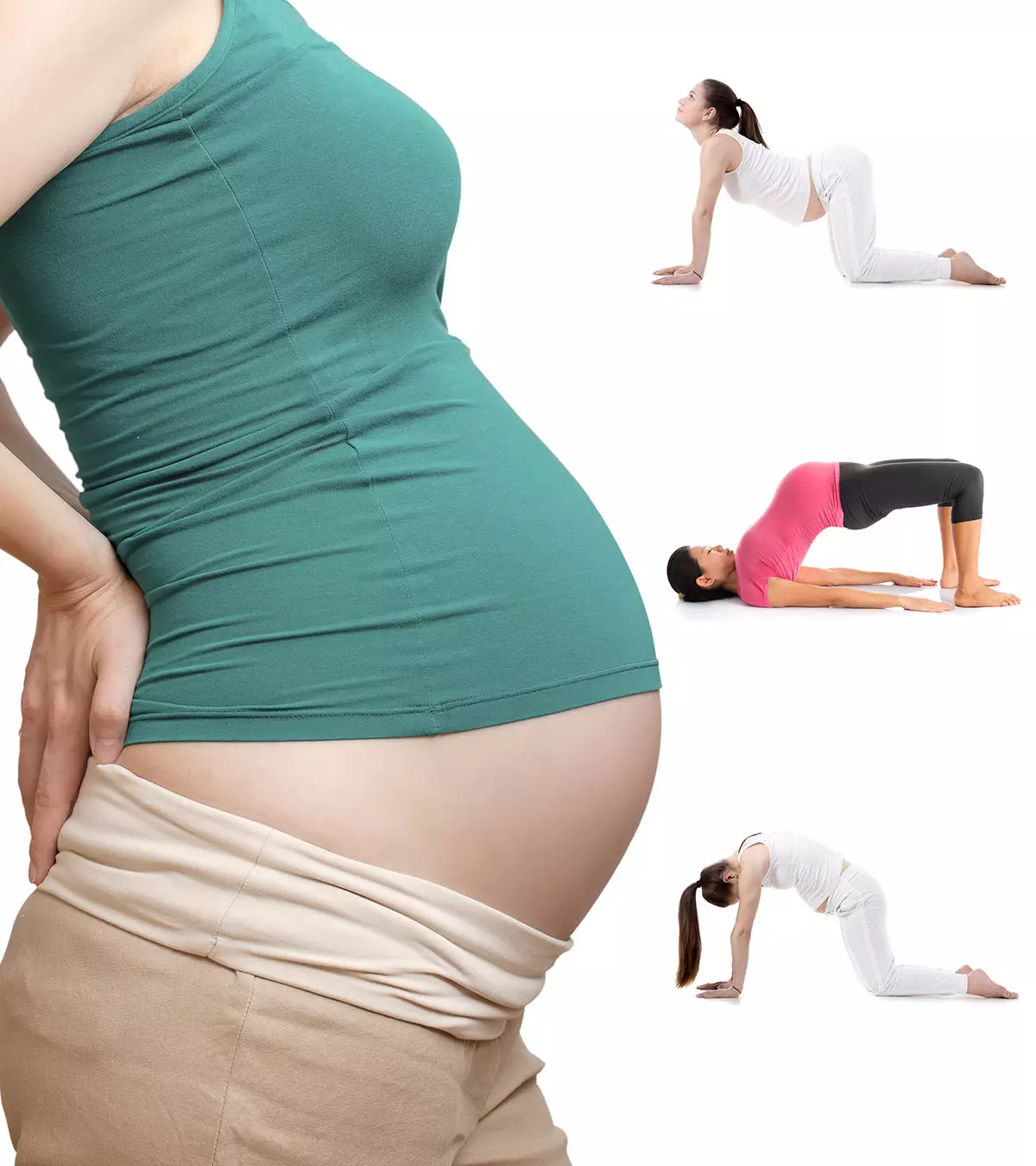
Image: MomJunction Design Team
The tailbone or coccyx is a small triangular bony structure situated between the upper buttocks (1). It stabilizes your sitting posture, and most muscles, tendons, and ligaments pass through the tailbone.
The tailbone pain, coccyx pain, or prenatal lower back pain, also known as coccydynia, is a sharp or dull pain at the end of the spine. If the pain is severe, it is called ‘bruised tailbone.’ Some pregnant women might experience this pain due to various reasons. Although there is no cure for this pain, some simple stretching exercises could help in reducing the pain to some extent. However, if the pain stays for a couple of days or if it gets worse, it is best to consult your doctor.
In this post, MomJunction presents information on why some women might experience tailbone pain during pregnancy and ways to reduce it.
Why Does Your Tailbone Hurt During Pregnancy?
Body aches in pregnancy, especially in the lower portion of the body, aren’t uncommon. As your fetus grows, the pressure increases in the lower extremities, leading to tailbone pain. You could try to reduce this pain with gentle stretching exercises, says Alicia M Silva in her publication, ‘Preventing and Managing Back Pain During Pregnancy.
So, are there any other causes for tailbone pain during pregnancy?
1. Pregnancy hormones
In the first trimester, your body releases relaxiniA sex hormone produced by the ovary that loosens and relaxes muscles and joints during pregnancy. and estrogeniA female sex hormone responsible for the development of female sexual characteristics. hormones, which relax the ligaments of the pelvic region (2). The muscles shift around the abdominal region to create space for the baby. In this process, the tailbone also moves, which might lead to pain.
2. Growing baby
During the second and third trimester, the developing baby requires more space. It pushes against the tailbone, which lies just behind the uterus. This pressure causes pain and worsens with the progressing pregnancy, according to the book ‘Your Best Pregnancy’ by Jill Hoefs, MP and Denise Jagroo, DPT, MTC, WCS.
Dr. Callan Martin, a board-certified chiropractor from Overland Park, Kansas, says, “As your uterus begins to expand, your body will change its natural posture, and your pelvis will expand to compensate. As the uterus expands, pressure can settle over the sacrum and tailbone. When the body prepares for labor, the fetus will descend lower into the pelvic outlet with either head up or down against the tailbone.”
3. Other causes
In the later stages of pregnancy, when you cough or sneeze, it might put pressure on the tailbone, causing pain. Your increasing weight can cause you to lean back when you sit in odd postures. Therefore, cycling or sitting for long hours may cause tailbone pain, especially during pregnancy.
 Did you know?
Did you know?Prenatal Yoga Stretches To Ease Tailbone Pain
Dr. Martin says, “I encourage my pregnant patients to remain active during their pregnancy and focus on strengthening and flexibility to aid not only in delivery but also recovery. Pelvic floor specialists, physical therapists, or chiropractors can help develop a specific program for your needs.”
Prenatal physical therapy can help in relieving pain and smoothen labor and delivery. According to the American College of Obstetricians and Gynecologists (ACOG), modified yoga and prenatal pilates can benefit pregnant women. However, ACOG recommends practicing prenatal yoga as per expert guidance and avoiding poses requiring being still or laying on the back for a long time (3).
Gentle exercises and stretches help reduce the pain in the tailbone, offer relaxation, and prepare the body for childbirth. However, it is advisable to consult your physician before exercising during pregnancy. A physiotherapist may help you perform the exercises to support your tailbone.
1. Torso twist
- Sit on the floor with crossed legs.
- Now hold your left foot using your right hand.
- Place your left palm behind you on the ground and twist your upper body to your right gradually.
- Remain for a few seconds, return to the starting position, and then repeat on the other side.
- Repeat ten times.
2. Cat-cow pose
This pose strengthens your pelvis and lower back. It takes the pressure off from the tailbone and increases your spine mobility. This form of pelvic tilt exercise works on your arms, back, and abdominal muscles.
- Bend on your hands and knees by keeping your hands under your shoulders and knees under your hips.
- As you inhale, raise your head gently, drop your belly, lift your chin and chest, and draw your shoulder away from your ears. This is a cow pose.
- As you exhale, release your head gently, press into your hands, round your back, and bring your chin towards your chest. This is a cat pose.
- Inhale while you come into cow pose and exhale while you come into cat pose.
- Repeat it ten times.
Lindsey Bomgren, a mother of three and a personal fitness trainer shares the unique benefit of the seated cat-cow pose that she observed during her pregnancy. She says, “I’ve tried it and it does work that if you do belly breathing (during cat pose) in tabletop position before bed for two minutes, it alleviates the number of times you have to pee in the middle of the night (i).”
3. Standing cat-cow pose
It is similar to the above stretch but is performed standing. It offers mobility to the spine and relieves you from tailbone pain. It works on all the muscles mentioned above plus the leg muscles, and glutes.
- Stand with your legs hip-width apart, knees bent, and hands placed on thighs.
- As you inhale, arch your back, drop your belly, and raise your head upwards.
- As you exhale, round your back, tuck your pelvis by releasing your head gently.
- Alternate the positions while repeating them for about ten times.
4. Bridge
This gentle stretch strengthens your hip flexor muscles. It works on your abdominal muscles, lower back muscles, and glutes. It also relieves you of lower back and hip pains. Avoid this exercise after your 20th week of pregnancy.
- Lie on your back with feet flat and knees bent. Keep your hands beneath your back with palms facing downward.
- Move your feet so that they are hip width apart from each other. Lift up your pelvis by pressing your lower back against the floor. Hold the pose for a minute and breathe in.
- Now release the pose by exhaling. Roll your spine back to the ground slowly.
- Repeat ten times.
5. Downward-facing dog pose
This stretching pose strengthens your lower back and the back of your legs and lengthens your spine. It works on foot muscles, quads, triceps, and lats.
- Begin on all your fours with knees under your hips and wrists below your shoulders.
- With the support of arms and legs, as you inhale, gently lift your hip as you stretch the back of your legs and extend your arms
- Exhale by relaxing your heels and head. If you feel tight in the calf region, you can pedal your feet (like pressing one heel down, followed by the other).
- Once you are done with the pose, slowly move your knees downwards and rest for some time in child’s pose.
Caution:
It is an inversion poseiA pose in which your heart and hips are at a higher level from the ground when compared to the head. , and you should avoid doing it in your third trimester, which is after 33 weeks of pregnancy. Do not practice this pose without talking to your physician.
6. Child’s pose
It is another stretching exercise for your back and hip. It effectively eases the lower back, pelvic, and tailbone pain.
- Kneel on both your knees with a slight distance in between them. Then sit on your heels and bend forward by lowering your forehead to the floor. You can widen your toes if you feel that touching your toes puts any pressure on the knees or does not provide enough space for the stomach. You can also offer support to your abdomen by placing a pillow between your knees.
- Keep your arms along the body with palms facing upward.
- Gently bring your chest towards the thighs and hold for at least five deep breaths.
- Now, while exhaling, slowly release your butt on your heels, uncurling the spine.
7. Pigeon Pose
Image: Shutterstock
Practicing Pigeon Pose during pregnancy can be of immense help in managing the tailbone pain. But keep in mind that you need to change the pose a bit by using a chair for help. Pigeon Pose, with chair support, aids in opening the hips and increasing flexibility in the abdominals, piriformis, and shoulders. Here’s a step-by-step guide:
- Begin seated with feet hip-width apart.
- Gently place the left ankle on the right thigh, ensuring a comfortable position.
- Hold for a minute. Swap sides slowly.
While seated, take advantage of the position to indulge in a soothing foot massage. These modifications provide stability, reducing strain during the practice. Remember, safety is paramount during pregnancy, so listen to your body, proceed mindfully, and enjoy the stretching and relaxation benefits.
Some other activities that might help are:
Swimming
Swimming on the back with minimal thigh movements relieves the back strain. It could be a good exercise to fight the tailbone pain during pregnancy. However, take your doctor’s advice before opting for swimming, and make sure you enter into a neat and hygienic pool.
Walking
Walking might take off the pressure from the tailbone and also help in preventing weight gain. It is believed that regular walking for at least 30 minutes will relieve strained muscles of the pelvic region as well.
Risk Factors For Tailbone Pain During Pregnancy
If you have suffered from tailbone pain before conception, it might get aggravated during pregnancy. The pre-existing conditions that could intensify the pain include:
- Symphysis pubis dysfunction (SPD): It is a condition in which the ligamentsiA band of muscles connecting bones, usually at a joint. that align pelvic bone during pregnancy become relaxed or stretchy. This causes pain in the pubic bone and aggravates tailbone pain (4).
- Constipation
- Lower back injury
- A herniated disciThe condition in which the rubbery cushions or discs between the vertebrae slip into the spinal canal. in the lower back: In this case, tailbone pain occurs in the sacral regioniThe area between the lumbar spine and the coccyx. , or in the right or left buttock. This prenatal sacral pain will radiate down to the leg and cause a prickling sensation down to the feet. It may also be called prenatal sciatica (5).
You should check with your physician if the pain is severe or lasts for several days. They will examine if there is any deviation in the tailbone region. Radiology tests like CT scans and X-rays are avoided while you are pregnant since the radiation is harmful to your baby (embryo or fetus).
Tips To Relieve Tailbone Pain During Pregnancy
1. Good posture
Poor posture might be one of the contributing factors for peripartum coccyx pain. Try to sit upright with your core engaged, feet flat on the ground, neck straight, and back slightly curved. You can also look for comfortable chairs with proper lumbar support to maintain good posture and prevent pressure on the tailbone. If you feel any discomfort, try changing the position by crossing one ankle over the knee or leaning forward at the waist. It helps in clearing the prenatal pelvic discomfort and therefore alleviating the pain (1).
2. Sleeping position
Sleeping on the sides will be more comfortable than sleeping on the back if you are suffering from tailbone pain. The best position is to sleep towards the left side. It will not only help in relieving the pain but might also improve circulation to the placenta. You may also use a cushion or a pillow in between your knees.
3. Right clothing
Tight clothing, especially tight pants, will aggravate the pain. Instead, try loose-fitting clothes that do not put any pressure around the tailbone.
4. Cushions for sitting
Try to avoid sitting on hard surfaces. Use a U-pillow or a donut pillow for sitting (1). You can also sit on an exercise ball to avoid pressure on the coccyx. Ergonomic chairs might be a good option if you sit for long hours at work.
“There are specially made cushions for coccydynia (tailbone pain). They are usually made of a memory foam with an opening for the tailbone. These will support the hips and pelvis while relieving pressure on the tailbone. However, a pillow with enough padding will also provide the same relief,” suggests Dr. Martin.
5. Maternity belt during later stages
A maternity belt will support your belly. It might relieve fatigue by reducing pressure on the lower back exerted by work that you engage in. You can start wearing it from the end of the second trimester and continue all through the third trimester.
6. Keep changing positions
Do not stand or sit for long hours. You can change positions and indulge in short walks. Also, do not bend down to pick any objects from the floor.
7. Heat pads
You may sit on a heating pad or apply a warm compress to the tailbone region to lower the pain. Using the hot compress for about 20 minutes, four times a day might help.
 Expert says
Expert says8. Comfortable shoes
Wear flat and comfortable shoes or flats instead of high heels. You can also prefer wearing shoes with cushy soles.
9. Empty bowels regularly
Irregular bowel movements can aggravate the pain as a full rectum builds pressure on the coccyx. Consuming fiber-rich food, brisk walking, and gentle stretches can promote smooth bowel movements.
10. Avoid jerky movements
Switch your positions from standing to sitting or vice versa in a gentle manner. Sit and stand slowly, and do not rush. Avoid sudden movements that could jerk your lower back
11. Tailbone massage
You can go to a physiotherapist or a pregnancy chiropractor to get prenatal massage therapy for your tailbone area. It helps to a great extent.
 Quick fact
Quick factPossible Medications For Tailbone Pain
Usually, doctors might prescribe physiotherapy to reduce tailbone pain. However, in some cases, acetaminophen (Tylenol) could be an effective pain reliever (6). In any case, do check with your doctor before you take it.
If severe pain persists, your doctor might inject a local anesthetic, a steroid, a combination of an anesthetic and steroid, or a nerve block in this area. An oral antidepressant could ease the pain too. But seek your doctor’s advice before trying these treatment options.
Consider C-Section In The Case Of Coccygea
A C-section might remove the fear of intense pain on the tailbone, say Stephanie A. Prendergast and Elizabeth H. Rummer in their book, Pelvic Pain Explained. You should talk to your gynecologist or obstetrician about it.
Can Tailbone Pain Be Cured?
According to Intermountain Healthcare, tailbone pain can be severe, slow, and difficult to heal. Home remedies and some medications can help to reduce the pain. Adequate rest and protection are recommended to promote healing (7).
Although there is no cure for it, pain may fade away by itself in a few weeks to months after delivery. If the pain lasts long or is severe, and you notice any unusual symptoms, please talk to your doctor.
Frequently Asked Questions
1. Can sleeping on your back cause tailbone pain?
As pregnancy progresses, a pregnant woman’s weight increases. In such a state, sleeping in the supine position can put pressure on the tailbone and hurt.
2. Does tailbone pain mean labor is near?
Lower back or tailbone pain during the later days or weeks of pregnancy may indicate that the labor is nearing. Tailbone pain indicating labor doesn’t go away when you change positions or move (8). Rather, it intensifies in frequency and intensity as you near the labor.
3. Can childbirth cause tailbone pain?
During labor, the ligaments around the coccyx (base of the spine) are strained during pushing. It could lead to tailbone pain after childbirth. Usually, it takes six to 12 weeks for the coccyx to heal and the pain to resolve (9). Some women may continue to experience discomfort in their tailbone. In such cases, consult a doctor for ongoing pain management and physical therapy.
4. Can tailbone pain affect the ability to move during pregnancy?
Yes. Tailbone pain, along with the growing uterus during pregnancy, can make basic movements, such as sitting and standing, painful or uncomfortable.
Tailbone pain during pregnancy can be caused by pregnancy hormones, the pressure exerted by the growing baby, and an increase in weight. While it has no cure, gentle exercises and prenatal yoga stretches such as the torso twist, cat-cow position, and bridge pose can help relieve tailbone pain. In addition, maintaining good posture and proper sleeping positions, wearing comfortable clothing and shoes, using u-pillows while sitting, and wearing a maternity belt could help relieve tailbone pain. You could also consider getting a tailbone massage from a certified physiotherapist experienced in handling pregnant women.
Infographic: Stretching While Pregnant
Gentle stretches during pregnancy may strengthen your muscles, relax you, and may relieve body pain, including tailbone pain. While some stretches provide the above benefits, others may cause injuries and are better avoided. However, there are a few things to consider while engaging in stretching during pregnancy.
Take a look at this infographic to understand the guidelines to follow while performing stretches during pregnancy and also the stretches you must avoid. Illustration: Momjunction Design Team
Key Pointers
- The tailbone is a small, triangular bony structure located at the lower end of the spine, between the upper buttocks.
- Some women experience tailbone pain during pregnancy due to changes caused by pregnancy hormones, growing babies, and weight gain.
- Simple prenatal yoga poses and stretches, including the torso twist, cat-cow pose, and child pose, can manage and reduce tailbone pain.
- Pre-existing conditions like symphysis pubis dysfunction (SPD) and a herniated disc can aggravate the pain during pregnancy.
- Maintaining the right and comfortable posture, sleeping on the side, wearing comfortable clothing, and using heat pads can help relieve the pain to some extent.
- In cases of severe and persistent tailbone pain during pregnancy, the doctor may advise medications, along with physiotherapy and adequate rest.
Are you feeling an uncomfortable and painful sensation in your tailbone area? Check out this video for a few easy stretches to help relieve the discomfort.
Personal Experience: Source
MomJunction articles include first-hand experiences to provide you with better insights through real-life narratives. Here are the sources of personal accounts referenced in this article.
i. 8 best pregnancy stretches for lower back pain relief;https://www.youtube.com/watch?v=B8bTXHnyGGM
References
1. Lesley Smallwood Lirette, et al.; Coccydynia: An Overview of the Anatomy, Etiology, and Treatment of Coccyx Pain; The Ochsner Journal
2. MacLennan AH; The role of the hormone relaxin in human reproduction and pelvic girdle relaxation; NCBI
3. Exercise During Pregnancy; American College of Obstetricians and Gynecologists
4. Emily R. Howell; Pregnancy-related symphysis pubis dysfunction management and postpartum rehabilitation: two case reports; The Journal of the Canadian Chiropractic Association
5. Herniated Disk; Harvard Health Publishing
6. Pain Relievers; Medline Plus; US National Library of Medicine
7. Coccydynia; Intermountain Healthcare
8. CONTRACTIONS AND SIGNS OF LABOR; March Of Dimes
9. Coccyx pain following childbirth (postnatal); NHS
10. What to do when pregnancy becomes a pain in the tailbone; UT Western Medical Center
11. Tailbone (coccyx) pain; NHS
Community Experiences
Join the conversation and become a part of our nurturing community! Share your stories, experiences, and insights to connect with fellow parents.
Read full bio of Dr. Kofi Kwaw-Asante
- Graduating from Logan University in 2010, Dr. Callan Martin has advanced training in sports medicine, pediatrics and perinatal chiropractic care. He has practiced in the Overland Park, KS area since 2013 and is in private practice at Back On Track Chiropractic + Acupuncture.
 Graduating from Logan University in 2010, Dr. Callan Martin has advanced training in sports medicine, pediatrics and perinatal chiropractic care. He has practiced in the Overland Park, KS area since 2013 and is in private practice at Back On Track Chiropractic + Acupuncture.
Graduating from Logan University in 2010, Dr. Callan Martin has advanced training in sports medicine, pediatrics and perinatal chiropractic care. He has practiced in the Overland Park, KS area since 2013 and is in private practice at Back On Track Chiropractic + Acupuncture.
Read full bio of Rebecca Malachi
Read full bio of Swati Patwal
Read full bio of Aneesha Amonz






